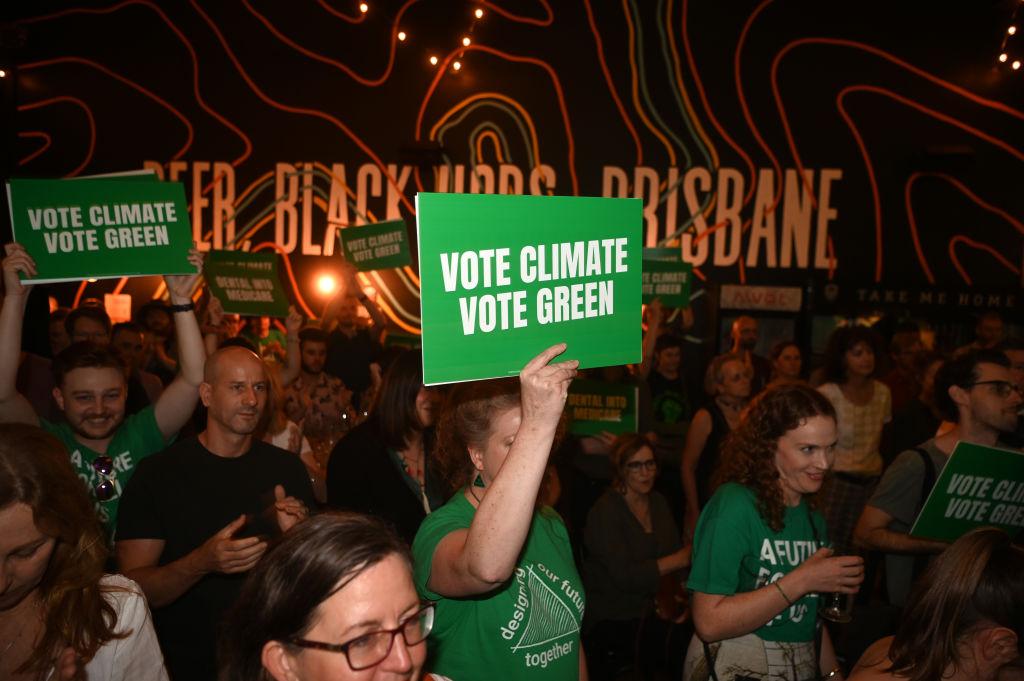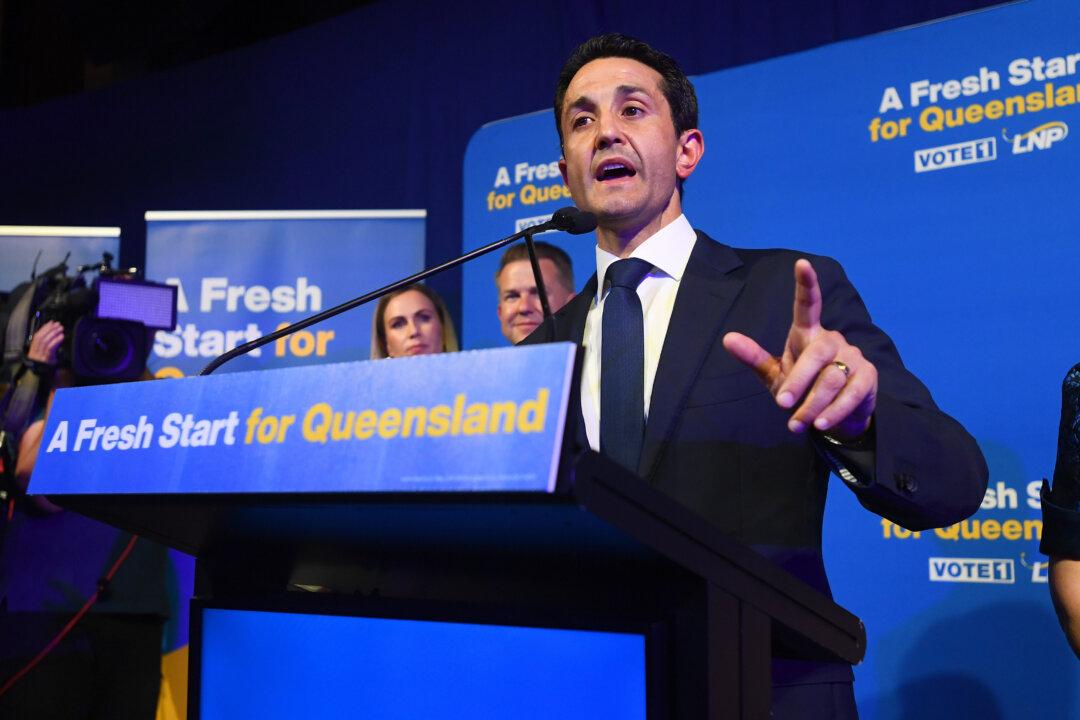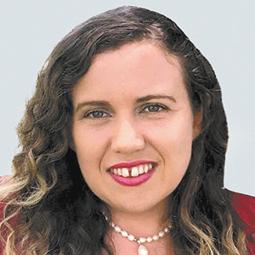As the dust settles on the defeat of the decade-long Labor government in Queensland, key trends will be examined with interest from political strategists around the country—notably with the federal election on the horizon.
Liberal National Party (LNP) Opposition Leader David Crisafulli’s team secured a 7.1 percent swing, taking a swathe of seats from the incumbents.
While the Labor Party dominates metropolitan Brisbane, and the LNP maintains a strong presence across regional seats—both parties do not have the numbers to secure power from their relative strongholds, and need to capture key electorates along the Queensland coast.
Not Quite the 2012 ‘Blue Wave,’ But Still Decisive
“This is historically large,” said Graham Young, executive director of the Australian Institute of Progress (AIP).“The swings were larger in regional Queensland than in Brisbane, but there were swings everywhere,” he told The Epoch Times.
In fact, solid Labor outer suburban seats in the party’s stronghold of Brisbane recorded major swings against it.
While the government managed to weather the storm having built large enough margins over three consecutive terms—the fallout will likely pique interest from Liberal Party strategists hoping to win over traditional Labor voters in the outer suburbs of the country’s big cities.
Safe Labor seats like Algester recorded a 10 percent swing against it, Logan recorded a 9.5 percent swing, Stafford 7.2 percent, and Capalaba 11.5 percent, with the LNP looking likely to win after 65 percent of votes were counted.
Among the deciding coastal electorates, voters emphatically rejected Labor’s policies and chose the LNP, notably the three seats covering the northern city of Townsville, the electorate of Cook, Barron River, Maryborough, Keppel, and Hervey Bay.
Cost of Living, Crime Still the Big Issues
Cost of living was the single biggest factor affecting Queenslanders, according to Griffith University political expert Paul Williams.Labor likely drew in some voters with its initiatives including 50 cent public transport fares, cheaper car registration, and proposals for public-owned petrol stations and medical clinics. But they were not enough.

Cost-of-living, according to experts, will likely shape Australian elections into the near future with the federal Albanese government already feeling pressure on this.
“The ALP has worn the blame for bad economic times which they have also been the author of,” Young said.
Last Minute Abortion Campaign Worked
When Labor MP and Member for Bundaberg Tom Smith told The Epoch Times that abortion was the biggest factor in the state election, his claim may have been partly accurate.Smith sat in the most marginal seat in the state, and enjoyed a 5 percent swing his way on election night—an outlier compared to other coastal electorates.
Just how big an influence Labor’s pro-abortion stance had on the election outcome can only be a guess, but if Williams had to put a number out, it would be a big one.
“There’s no doubt it’s swung thousands, if not hundreds of thousands of votes,” he said.
Williams said many previous Labor and Greens voters would have been left thinking, “Why are we still talking about this?”
The abortion debate was a latecomer to the Queensland campaign, emerging only after Katter’s Australian Party’s (KAP) Robbie Katter suggested his party would put forth a bill to scale back the state’s abortion laws.
That promise led to speculation that the LNP, who had largely not supported the idea, would bolster the KAP and restrict access to procedures such as late-term abortions.
Crisafulli repeatedly told reporters he had no plans to change the state’s abortion laws, but the seeds of doubt were sown.
“One little slip of the tongue [from KAP] can change history, and that’s what happened,” Williams said.
Meanwhile, the AIP’s Young said a bigger swing would have been possible if abortion hadn’t been raised, or if the LNP had put it to bed sooner.
“This was an importation into Queensland politics of U.S. political tropes,” Young said.
Money Talks
Young said the financial heft of the union movement and its advertising campaigns were decisive.“Unions had the ability to spend money at the same time as the major parties were restricted in their ability to both spend money and raise it.
“The saw the Labor Party hold seats like Aspley that they should have lost. Union funds went in to support the sitting member.”
Why the Greens Flunked in the City
One surprise result from the election was the Greens.The left-wing minor party had aimed to double its seat count, hoping to capitalise on its previous run of success.
In Queensland, while the Greens overall vote increased around the state, it did not increase where it mattered most: in the inner city.

Currently, the Greens are still sweating on if they can hold their only two seats: South Brisbane and Maiwar.
The party could lose South Brisbane with a hefty 12.4 percent swing to Labor, while the leafy, affluent Maiwar—held by the Greens since 2017—has edged back and forth between the Greens and the LNP.
Political analyst Kos Samaras said voters had grown tired of the Green’s policy offerings and their criticisms of Labor.
“Greens voters are not Greens activists,” he wrote on X. “Greens voters actually float between Labor and the Greens. They at times also choose to support other progressive minor parties.
“Constantly attacking Labor, in an environment where conservative parties are gaining ground actually pushes progressive voters to Labor, not the Greens.”
Williams posits that the abortion issue could have gnawed away at the Green’s vote.
Progressive voters passionate about the issue may have may switched to Labor to form a bulwark against any potential threat to abortion rights.
Williams also says the modern Greens lack focus on environmental issues, and its foray into wider social and political issues may have cost it votes.
Young said this was the case.
“This undoubtedly reflects the Green’s overt move to supporting radical left-wing causes like those of terror organisations like Hamas and Hezbollah,” he said.
“They made themselves ‘uncuddly.’ No longer about the environment but about grievance politics.”
Why One Nation Failed to Fly in its Home State
One Nation did not pick up any seats in the Queensland state election despite maintaining the same overall vote.Williams was not optimistic about the future of the party, saying it was too reliant on party leader Pauline Hanson’s star power.
“The near-invisibility of Pauline Hanson impacted their vote as it did in 2020,” Williams said. “If you’re not Pauline Hanson, you struggle to get attention in One Nation.”
Despite having a federal parliamentary presence since 1998, Williams says One Nation’s vote has struggled since the pandemic.
He also thinks Senator Malcolm Roberts may soon be on the way out, and that the north Queensland-focused KAP may be eating into its support base.
“Their policies are covered already by the KAP in Queensland, and they do it better,” Williams noted. “One Nation’s become a culture wars party.”
During tough times, voters tended to lean towards material politics over and above idealism—if voters are stressed about putting food on the table, they are less likely to take a punt on social issues or ideologies.
Door Knocking Still Effective
Persistent door-knocking and face-to-face contact likely gave Labor a shot in the arm.On election night, Labor Premier Steven Miles commended the door-knocking effort of his team, while Treasurer Cameron Dick said the party had door knocked nearly 250,000 homes in the state.
Federal Aged Care Minister Anika Wells, the member for Lilley, revealed the candidate for Sandgate had personally door knocked 8,000 homes.
LNP’s Small Target Strategy Not Ideal
Williams also said the LNP was weakened by its “small target” strategy and catchphrases, rather than detailed policy.The academic said if the LNP had released one strong, detailed policy per month over a year, the “blue wave” would have been more like a tsunami.
A Big Job Ahead for the LNP
Crisafulli will now sink or swim to win a second term—a goal the now-premier outlined during his victory speech.“He’s set a very high bar, there’s a lot of work between now and Christmas,” Williams said.
Public goodwill could sour in 12 months if the new state leader can’t pull off enough of his promised feats.
Williams says solving hospital ramping in 100 days, as Crisafulli has promised, could be near-impossible without sourcing more doctors and nurses in a short time.
Meanwhile, there are also troubles on the horizon with low police numbers and a record number of school teachers either retiring or leaving the profession, prompting what Williams calls a “classroom cliff.”
“Within 12 months, people could see him as just another politician,” Williams said.








